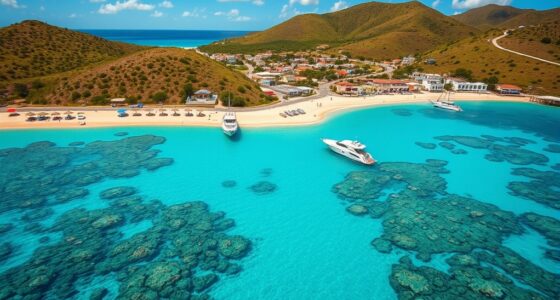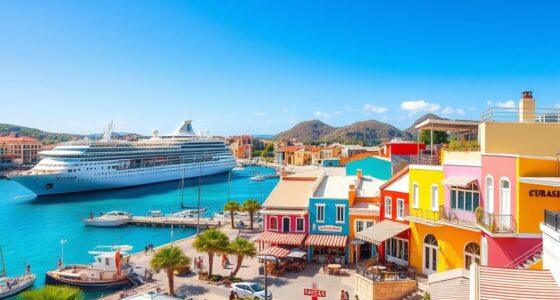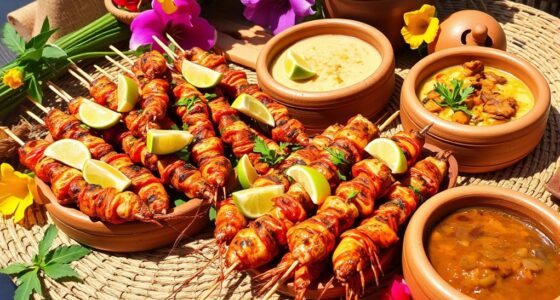Curaçao’s history and culture are a vibrant mix of indigenous roots, Dutch colonization, and African influences. You’ll find historic sites like Willemstad’s colorful UNESCO-listed architecture and Learn about how the island played a key role in the Atlantic slave trade. Its traditions, music, cuisine, and diverse population reflect centuries of resilience and multiculturalism. If you look further, you’ll discover the fascinating stories behind its heritage, community, and ongoing cultural richness.
Key Takeaways
- Curaçao’s history is shaped by Indigenous Caquetio roots, European colonization, and its pivotal role in the Atlantic slave trade.
- The island’s cultural heritage reflects a blend of African, European, Caribbean, and Jewish influences.
- Willemstad’s UNESCO-listed colorful architecture symbolizes its colonial past and multicultural identity.
- Significant events include the 1795 slave rebellion led by Tula and the abolition of slavery in 1863.
- Traditional music, dance, and festivals like Carnival highlight Curaçao’s vibrant, diverse cultural traditions.
Indigenous Roots and Early Inhabitants

Long before European contact, the island of Curaçao was inhabited by the Caquetio people, an Arawak-speaking indigenous group from what is now Venezuela. You can still find traces of their presence in ancient pottery, tools, and shell middens scattered across the island. They settled here between 500 BC and 500 AD, living as farmers, fishermen, and hunters. The Caquetio built simple villages near water sources, relying on the island’s natural resources for survival. Their society was organized around kinship and community, with a rich oral tradition. When Europeans arrived, their population declined sharply due to disease and colonization. Yet, their legacy endures through archaeological sites and the cultural influences that shape Curaçao today. Promoting biodiversity and protecting archaeological sites can help preserve this rich heritage for future generations.
European Contact and Colonial Foundations
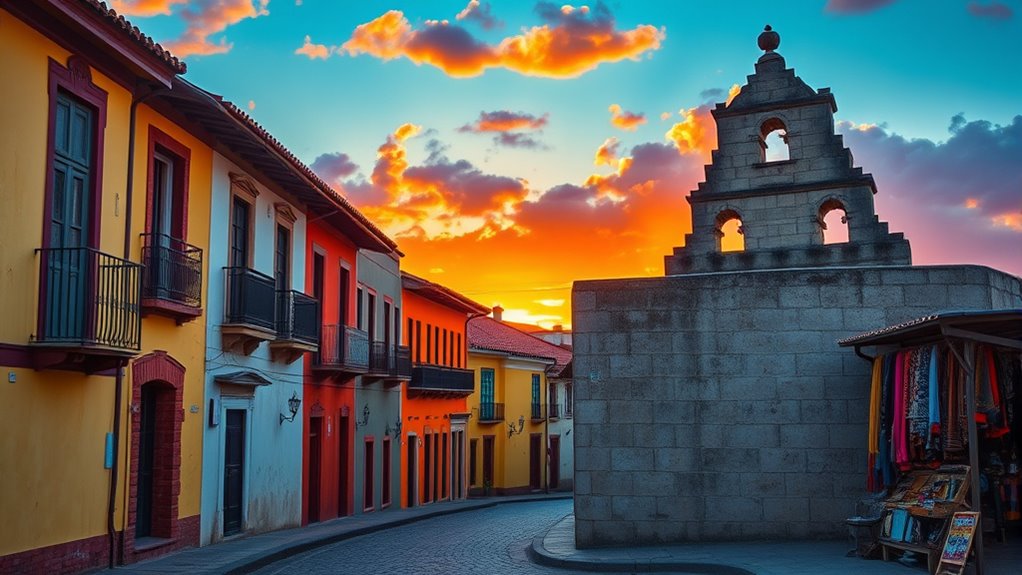
European explorers arrived on Curaçao in the late 15th and early 16th centuries, bringing profound changes to the island’s inhabitants. You see, Spanish control began in 1526, lasting 125 years, and drastically reduced the indigenous population. When the Dutch seized the island in 1634, Curaçao transformed into a crucial trade hub, especially in salt and later oil refining. You can imagine the strategic importance of Willemstad’s natural harbor and Fort Amsterdam.
| European Power | Impact on Curaçao |
|---|---|
| Spain | Initial control, population decline |
| Netherlands | Trade, fortification, economic growth |
| Indigenous | Population reduction, displacement |
| Africans | Enslavement, labor force |
The Dutch Takeover and Development of Willemstad

When the Dutch seized Curaçao in 1634, they quickly recognized the strategic importance of Willemstad’s natural harbor, Schottegat. You see, they began developing the city into a crucial trading hub, constructing fortifications like Fort Amsterdam in 1636 to protect their interests. Willemstad’s colorful colonial architecture took shape, with Dutch-style buildings lining the waterfront, creating a vibrant port skyline. The Dutch expanded infrastructure, turning Willemstad into a key center for Atlantic trade and slave commerce. Over time, the city grew in prominence, attracting merchants, settlers, and diverse communities. Its strategic location and well-planned layout made Willemstad a bustling maritime city, shaping Curaçao’s economy and culture for centuries. Today, the city’s historic core remains a UNESCO World Heritage site, a symbol of Dutch influence. Additionally, the development of tableware in trade and social settings contributed to the cultural exchanges that enriched Willemstad’s diverse community.
The Role of Curacao in the Atlantic Slave Trade
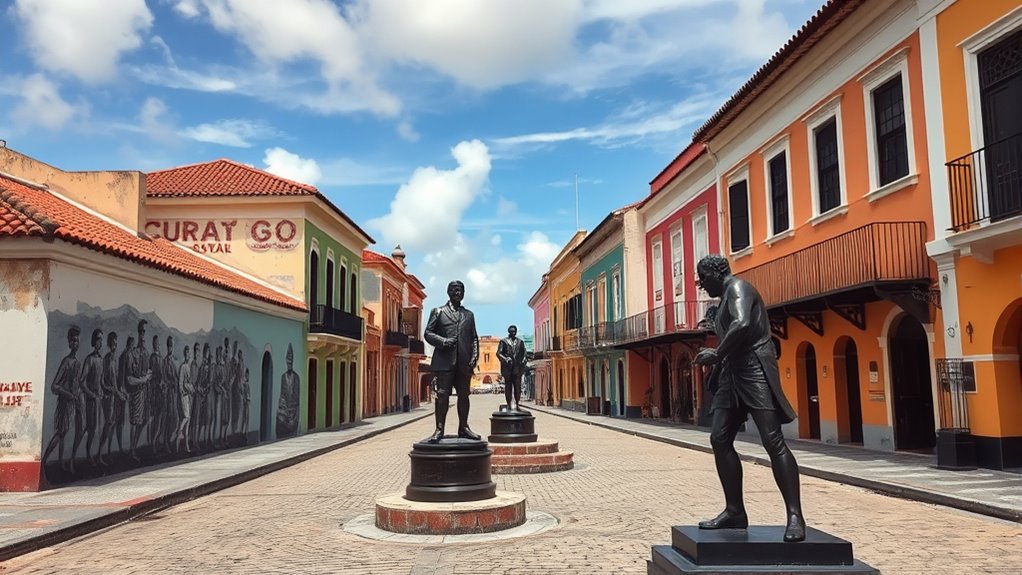
You should know that Curacao was a major hub for the Atlantic slave trade, with its bustling slave markets facilitating the movement of about 100,000 enslaved Africans. These individuals made harrowing journeys across the Atlantic before arriving on the island, where they were sold and put to work. As a result, the island’s demographics were permanently shaped by this history, leaving a legacy that still influences its diverse population today. The legacy of this history is also reflected in the island’s rich cultural traditions and food influences, which incorporate elements brought by enslaved peoples.
Major Slave Market Hub
Curacao played a pivotal role as a major hub in the Atlantic slave trade, serving as a key port where enslaved Africans were brought and sold. Its natural harbor, Schottegat, became a bustling center for the transatlantic trade, connecting Africa, Europe, and the Americas. Slave ships would arrive regularly, unloading their human cargo at the marketplace, where enslaved people were auctioned to plantation owners and traders. Curacao’s strategic location made it an ideal staging point for the movement of enslaved Africans to nearby Caribbean islands and the mainland Americas. The island’s markets facilitated the transfer of over 100,000 captives, fueling the growth of colonial economies. This dark chapter left a lasting impact on Curacao’s demographic makeup, culture, and history, shaping its identity for centuries to come.
Enslaved Africans’ Journey
Have you ever wondered how the island became a central hub in the Atlantic slave trade? Curacao’s strategic location made it a key stopping point for ships transporting enslaved Africans. From 1634, when the Dutch took control, the island’s bustling port became a major transit point. Enslaved Africans were forcibly brought from West Africa, often via the Caribbean, and sold at the island’s slave markets. Many endured harsh conditions during the Middle Passage, with ships packed tightly in brutal voyages. Once ashore, they faced brutal labor in salt mining, plantation work, and other colonial enterprises. Curacao’s role in this grim journey helped fuel the economies of European colonies across the Americas, leaving a lasting mark on its history and the ancestry of its people. Understanding the history of the Atlantic slave trade provides crucial context for the island’s cultural and demographic development.
Impact on Local Demographics
The Atlantic slave trade profoundly shaped the island’s demographics, transforming its population into a vibrant mosaic of African, European, and Caribbean ancestries. You’ll see this in the diverse origins of Curacao’s residents, with about 85% of the population of African descent. The transatlantic movement of enslaved Africans through Curacao’s ports introduced African cultures, languages, and traditions that persist today. European influences remain strong, especially from the Dutch, Portuguese, and Sephardic Jewish communities, shaping local customs, religion, and language. The arrival of immigrants from Latin America, the Middle East, and Asia further diversified the demographic makeup. This blending of backgrounds led to the development of Papiamento, a creole language, and a multicultural identity that defines Curacao’s society and cultural heritage. Additionally, the legacy of the slave trade has contributed to ongoing discussions about cultural identity and social cohesion on the island.
Slave Rebellions and the Path to Emancipation

In 1795, enslaved people on Curaçao launched a large-scale revolt led by Tula, challenging their oppressors and demanding freedom. This rebellion became a pivotal moment in the island’s history, inspiring future efforts toward emancipation. After slavery was finally abolished in 1863, many freed individuals faced new struggles, shaping the island’s ongoing journey toward equality. The legacy of these slave rebellions continues to influence Curaçao’s cultural identity today.
1795 Slave Revolt
Despite the harsh realities of slavery, enslaved Africans on Curaçao organized one of the most notable revolts in Caribbean history—the Great Slave Revolt of 1795. You should know that this uprising was remarkable for its scale and leadership, inspiring future movements. Here’s what you need to understand:
- It was led by Tula, a charismatic slave, whose strategic planning challenged the authority of slave owners.
- The rebels temporarily seized control of parts of Willemstad, displaying their strength and unity.
- Although the revolt was eventually suppressed, it heightened awareness of the brutality of slavery and fueled calls for emancipation.
This revolt marked a pivotal turning point, showcasing enslaved people’s resilience and desire for freedom that would echo throughout history.
Tula’s Leadership Role
Tula emerged as a charismatic and strategic leader during the 1795 slave revolt on Curaçao, inspiring enslaved Africans to challenge their oppressors. Recognized for his intelligence and bravery, he unified diverse groups of enslaved people, rallying them to fight for freedom. Tula organized coordinated attacks on plantations, weapons caches, and the colonial authorities, demonstrating remarkable leadership under extreme danger. His courage and tactical skills boosted the rebellion’s morale and resilience. Though the revolt was ultimately suppressed, Tula’s leadership left a lasting legacy, symbolizing resistance against oppression. His actions galvanized future generations, highlighting the importance of leadership in the struggle for emancipation and justice. Tula’s courage made him a central figure in Curaçao’s history of resistance. Sustainable resistance strategies played a role in maintaining the morale and cohesion of the enslaved community during the uprising.
Emancipation Aftermath
The aftermath of emancipation on Curaçao was shaped by economic struggles and social shifts that kept many freed people in a cycle of poverty and tenant farming. You’ll see that, despite freedom in 1863, the island’s economy remained fragile, and many couldn’t escape poverty. Here’s what happened next:
- Economic hardship: Freed people often worked as tenant farmers, unable to own land or improve their conditions.
- Migration: Facing limited opportunities, many migrated to Cuba and other Caribbean islands for better work, especially in sugar and oil industries.
- Social tensions: Racial and economic disparities persisted, fueling inequality and social unrest that shaped Curaçao’s ongoing struggle for justice and progress.
- Tax implications: The economic hardships impacted the ability of freed individuals to plan for retirement, highlighting the importance of understanding IRA investment strategies for long-term financial stability.
These challenges defined the island’s path forward, influencing its culture, politics, and economy for generations.
Cultural Melting Pot: Immigration and Community Building
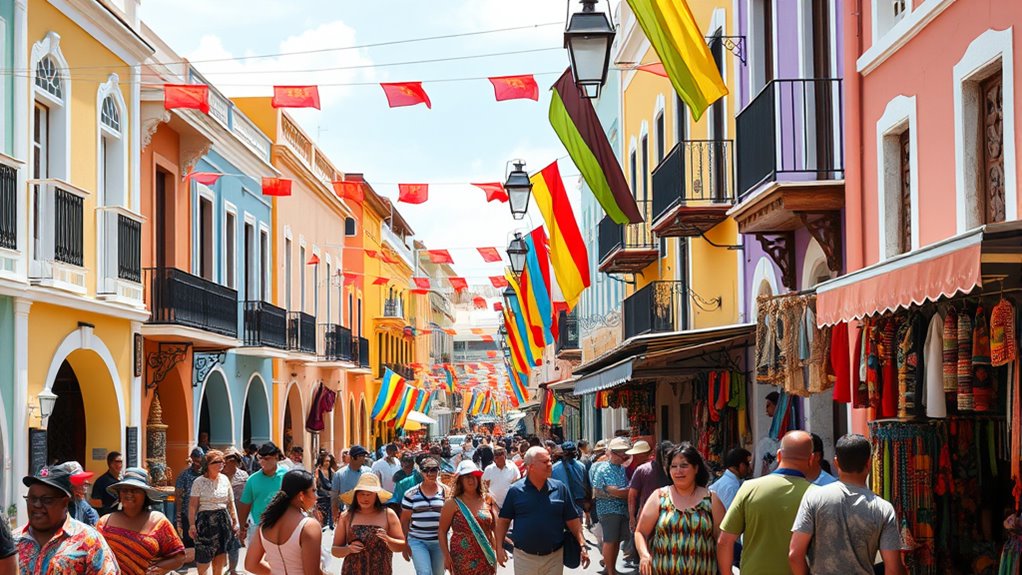
Curacao’s identity as a vibrant multicultural society results from centuries of diverse immigration that shaped its communities. You can see this in the island’s rich mix of cultures, languages, and traditions. When the Sephardic Jews arrived in the 1600s, they brought their customs, religious practices, and contributed to the economy, especially through commerce and trade. Later, the growth of the oil industry in the 20th century attracted workers from around the world—Latin Americans, Europeans, Asians, and Africans—turning Curacao into a true melting pot. Papiamento, the creole language, emerged from this mingling of influences, blending Dutch, Spanish, Portuguese, African languages, and Hebrew. The island’s cultural diversity has also been influenced by the impact of migration on community building and social cohesion. Today, the island’s diverse communities coexist, shaping its vibrant cultural landscape, music, cuisine, and social fabric.
The Jewish Community and Its Heritage
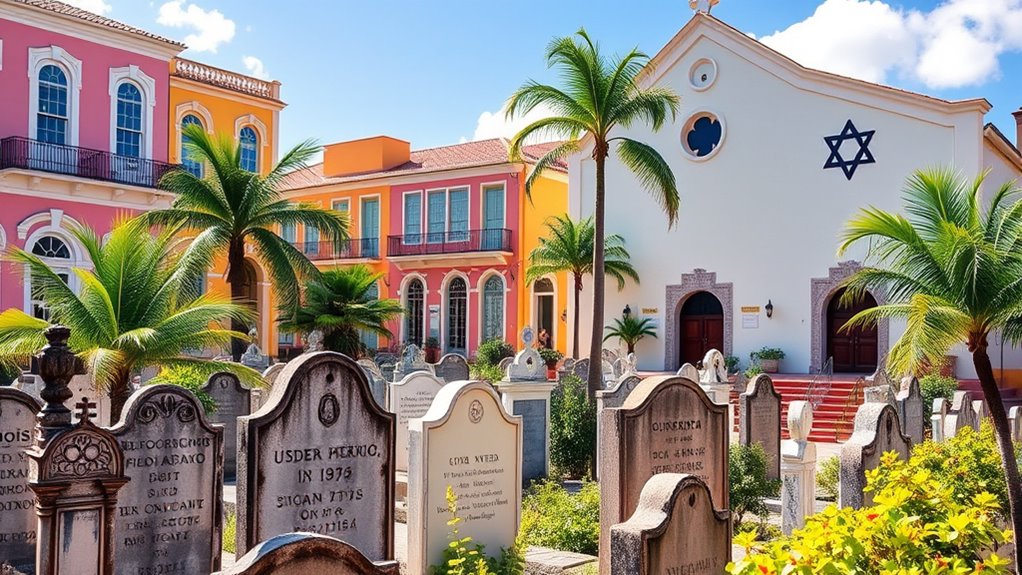
Among the diverse communities that have shaped Curacao’s vibrant culture, the Jewish population stands out for its resilience and lasting influence. You’ll find their impact in history, architecture, and traditions. Here’s what makes their heritage special:
- They arrived in the mid-1600s, fleeing Iberian persecution, and established a vibrant community.
- The Mikve Israel-Emmanuel synagogue, built in 1651, is the oldest continuously operating synagogue in the Western Hemisphere.
- Their contributions include commerce, cultural preservation, and the development of unique traditions like the use of Hebrew words in Papiamento.
Today, their legacy continues through historic sites, cultural festivals, and a community that honors its roots while blending into Curaçao’s diverse society.
Economic Shifts: Salt, Oil, and Modern Industries
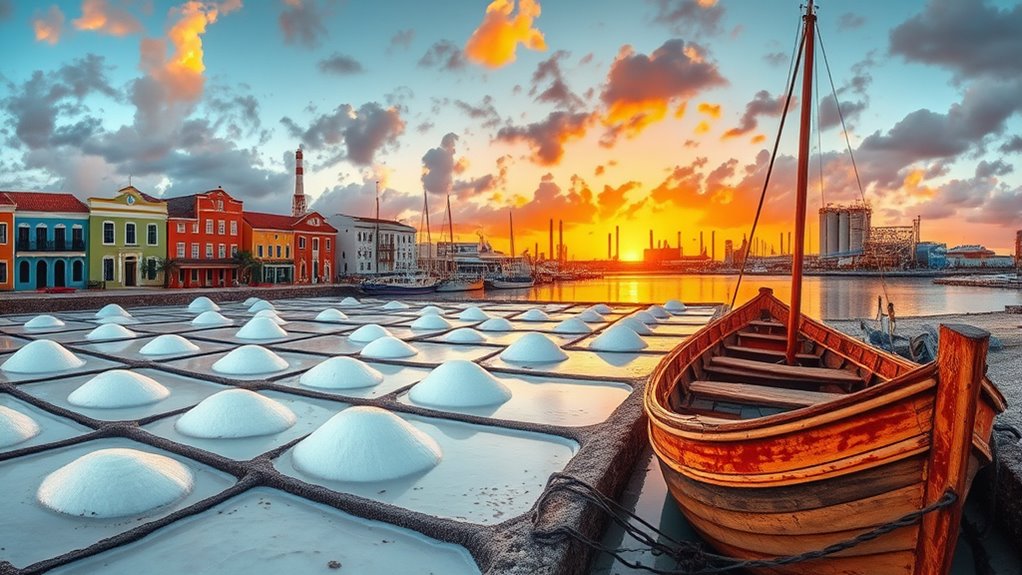
Salt harvesting once fueled Curaçao’s early economy, with vast salt flats and mines supporting trade and export. The salt industry thrived due to the island’s dry climate and natural evaporation ponds, making Curaçao a key supplier in Europe and the Caribbean. As the 20th century approached, oil became the new economic driver, transforming Willemstad into a regional refueling hub. The discovery of oil reserves attracted international companies, boosting employment and infrastructure development. Today, modern industries like tourism, offshore finance, and shipping dominate the economy. Cruise ships dock at Willemstad’s colorful port, bringing visitors enthusiastic to explore the island’s rich history. While salt and oil shaped Curaçao’s past, contemporary industries ensure its ongoing economic resilience and global connections. Additionally, the shift towards ethical hacking and cybersecurity has become increasingly relevant for protecting the island’s digital infrastructure in the modern era.
Political Evolution and Autonomy Within the Kingdom of the Netherlands
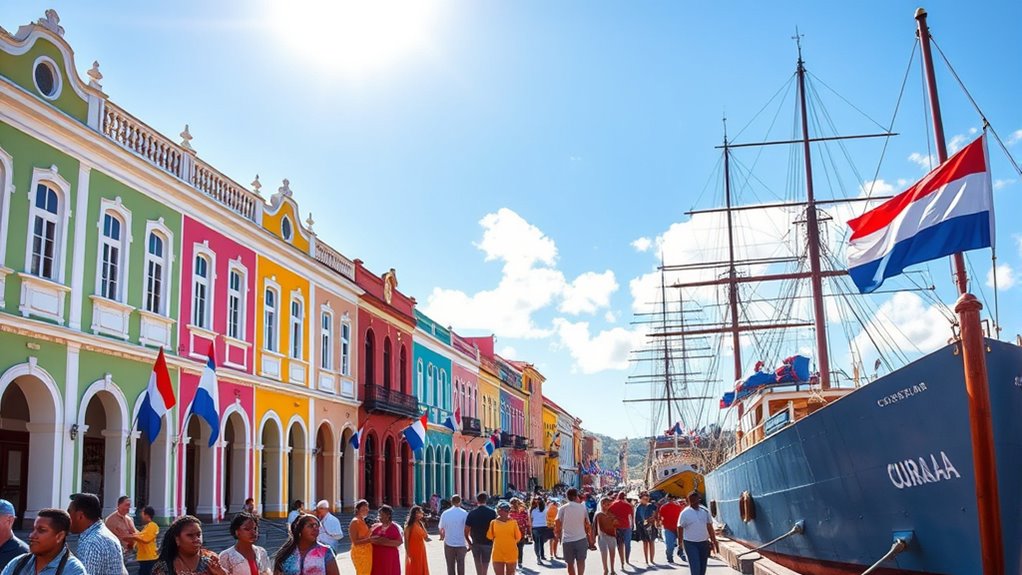
You see how Curaçao’s governance shifted from colonial rule to increased self-determination, especially after World War II. The island gained more political autonomy in 1954 and became semi-autonomous within the Dutch Kingdom in 2010. These changes reflect its path toward greater independence while remaining part of the Netherlands’ constitutional framework.
Colonial Governance Changes
Over the course of the 20th century, Curaçao’s political landscape evolved from direct colonial control to greater self-governance within the Kingdom of the Netherlands. You witness key changes, including:
- In 1954, Curaçao gained self-governing status, allowing local institutions to handle internal affairs while the Dutch maintained foreign policy and defense.
- The 1970s saw increased political participation, culminating in Aruba’s separation in 1986, which shifted governance dynamics.
- On October 10, 2010, the Netherlands Antilles dissolved, and Curaçao became a semi-autonomous country within the Dutch Kingdom, with its own government and parliament.
These shifts reflect Curaçao’s journey toward autonomy, balancing local identity with ties to the Netherlands.
Path to Autonomy
The political landscape of Curaçao has steadily shifted from colonial control toward greater self-governance within the Dutch Kingdom. In 1954, Curaçao gained self-rule as part of the Netherlands Antilles, giving it control over local affairs while remaining within the kingdom. This change reflected growing demands for autonomy, especially after World War II. In 1973, Curaçao elected its first Black prime minister, marking a significant milestone in political representation. When the Netherlands Antilles was dissolved on October 10, 2010, Curaçao became a semi-autonomous country within the Kingdom of the Netherlands, with its own government and parliament. This *progression* allowed Curaçao to manage most internal matters independently while maintaining a constitutional link to the Netherlands, balancing self-rule with kingdom-wide unity.
Modern Political Status
Have you ever wondered how Curaçao’s political landscape has evolved in recent decades? You’ll see that significant changes have shaped its current status. Here’s a quick overview:
- In 1954, Curaçao gained greater self-governance within the Kingdom of the Netherlands, managing its internal affairs.
- The 2010 dissolution of the Netherlands Antilles granted Curaçao semi-autonomous status, making it a country within the Dutch Kingdom.
- Since then, Curaçao has developed its own government, including a Prime Minister and Parliament, while the Kingdom retains control over defense and foreign policy.
Today, Curaçao operates as a semi-independent nation with local autonomy, balancing its cultural identity and political ties to the Netherlands.
Cultural Identity, Language, and UNESCO Heritage Sites
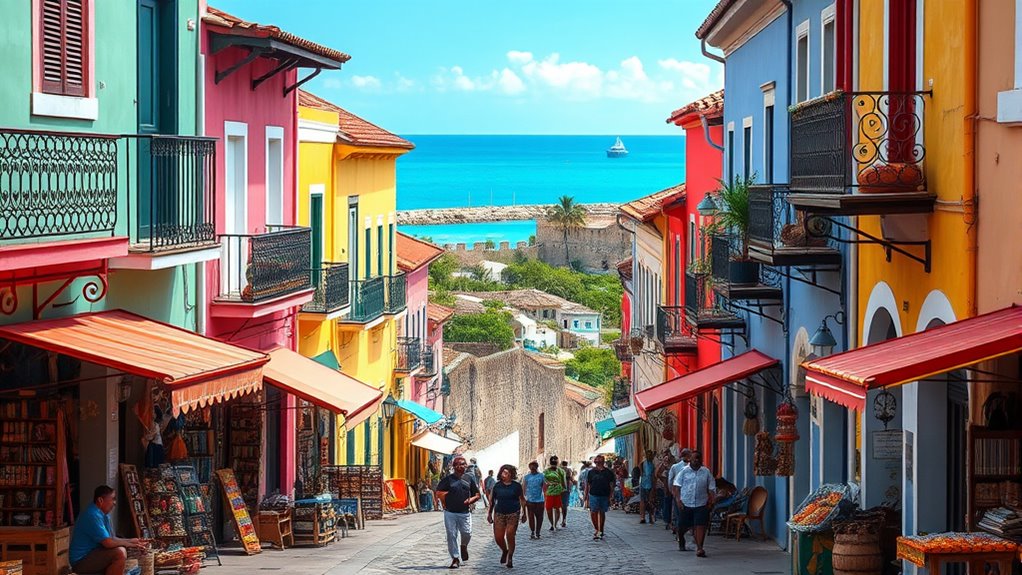
| Cultural Expression | Language and Heritage Sites |
|---|---|
| You feel Curaçao’s lively spirit in its music, dance, and festivals like Carnival, blending African, European, and Caribbean roots. | Cultural identity in Curaçao is a vibrant tapestry woven from its diverse history and peoples. Papiamento unites locals, reflecting centuries of multicultural influence, while Dutch remains the official language. |
| You’re drawn to Willemstad’s colorful architecture, a UNESCO World Heritage Site, showcasing Dutch colonial charm. | The UNESCO designation highlights the city’s historic significance and preservation of its unique identity. |
| The Jewish community’s Mikve Israel synagogue stands as a testament to resilience and cultural coexistence. | These heritage sites evoke pride and serve as living symbols of Curaçao’s complex history and multicultural fabric. |
| You embrace local traditions like tumba music and Seú dance, celebrating a shared cultural legacy. | Together, language, festivals, and heritage sites forge Curaçao’s unique cultural identity that you can experience firsthand. |
Frequently Asked Questions
How Did Papiamento Develop as a Creole Language in Curaçao?
You see, Papiamento developed as a creole language in Curaçao through the blending of Dutch, Spanish, Portuguese, African languages, and Hebrew, reflecting the island’s diverse population. As different groups interacted daily, they combined their languages into a new, simplified form for communication. Over time, this creole became the island’s common language, fostering cultural identity and unity among residents of various backgrounds.
What Are the Unique Cultural Traditions Associated With Curaçao’s Carnival Celebrations?
You’ll love Curaçao’s Carnival, where vibrant parades and elaborate costumes take center stage. Each year, over 50,000 people join the festivities, showcasing traditional music like tumba and seú. You’ll experience lively street parties, colorful floats, and energetic dance competitions. The celebration reflects a blend of African, European, and Caribbean influences, creating a unique, joyful atmosphere that unites locals and visitors in a colorful cultural expression.
How Has the Jewish Community Influenced Curaçao’s Cultural and Economic Development?
You’ll find that the Jewish community has markedly shaped Curaçao’s cultural and economic landscape. They established the oldest continuously used synagogue in the Western Hemisphere, Mikve Israel-Emmanuel, which highlights their lasting presence. Their entrepreneurial spirit helped develop commerce and trade, contributing to the island’s prosperity. Additionally, Jewish traditions and festivals enrich Curaçao’s multicultural identity, blending seamlessly with local customs, music, and cuisine, making the island truly diverse and vibrant.
In What Ways Did the Atlantic Slave Trade Impact Curaçao’s Demographic Composition?
You see, the Atlantic slave trade profoundly shaped Curaçao’s diverse population, bringing many Africans who contributed their rich cultures and traditions. This history created a vibrant, multicultural society, blending African, European, and Caribbean influences. The descendants of those enslaved people now make up the majority of the population, and their cultural legacies are woven into the island’s music, language, and customs, enriching Curaçao’s unique identity today.
What Is the Significance of Willemstad’s UNESCO World Heritage Designation?
Willemstad’s UNESCO World Heritage designation highlights its well-preserved Dutch colonial architecture and vibrant, colorful buildings, showcasing its rich history. You can appreciate how this status helps protect the city’s unique cultural identity and promotes tourism. It also encourages the preservation of its historic sites, fostering pride among locals. By recognizing Willemstad’s significance, UNESCO emphasizes its importance as a symbol of Curaçao’s diverse heritage and global cultural contribution.
Conclusion
You explore Curaçao’s rich history, embracing its indigenous roots, colonial legacy, and vibrant multicultural identity. You witness the resilience in its slave rebellions, the diversity in its Jewish heritage, and the resilience in its economic transformations. You celebrate its evolving political status, its UNESCO-listed sites, and its unique language. You recognize that Curaçao’s story is one of resilience, diversity, and unity—an enduring tapestry woven through centuries of change, culture, and community that continues to shape its future.



